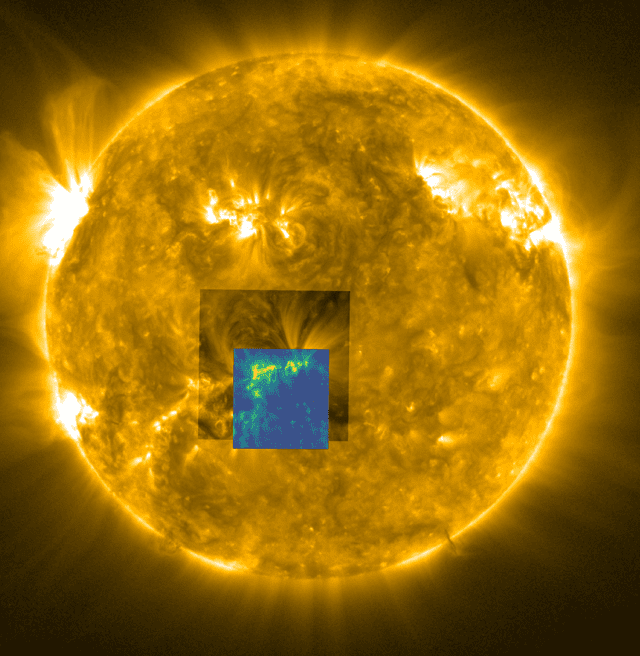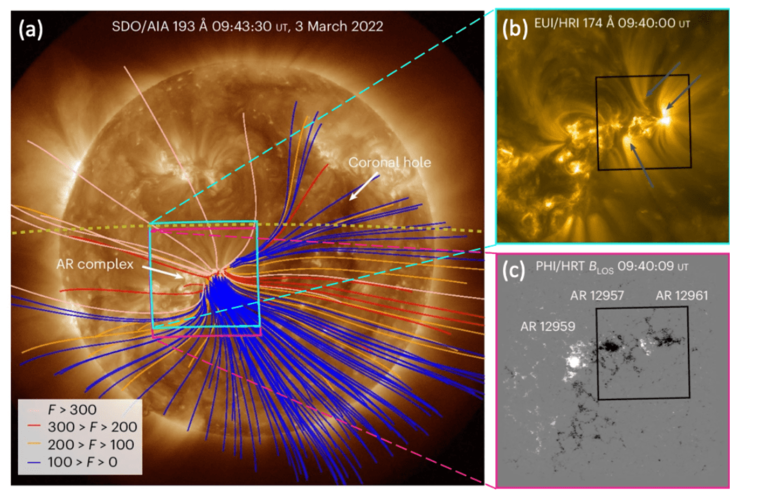An international scientific team (UK, Spain, USA, Italy, Ireland, France, Netherlands, Switzerland, Germany) has analyzed the Sun’s corona and solar wind, based on data sent back by the Solar Orbiter probe following its first pass close to the Sun in March 2022.
By combining solar images and data measured in situ, the international team was able to identify more clearly the origin of the slow-moving solar wind.
| What is the solar wind The solar wind is the continuous flow of charged particles (forming a plasma) from the Sun. It originates from a layer of the Sun’s atmosphere known as the solar corona. This plasma fills the entire heliosphere up to distances of 100 times the Earth-Sun distance. In the vicinity of the Earth, it typically moves between 300 and 800 kilometers per second. Below 500 km per second, the wind is described as "slow". |
Explanation in pictures
The researchers analyzed global views, taken in the extreme ultraviolet, of the very hot solar corona (a few million degrees). The brightest regions are the most heated ; they are called "active regions". The darkest regions of the solar corona are known as "coronal holes" ; these are the sources of the fast solar wind.


Close-up satellite views (such as figure 1b) show bright regions at the base of the corona, indicated by dark gray arrows. Researchers have observed upward plasma movements (figure 1c), identifying these active zones as the source of the slow-moving solar wind.
Based on these observations, the scientists used calculations to model the magnetic field lines that are released. Shown in color (Figure 1a), the lines extend outwards, away from the Sun ; they are open.
Their calculations have provided a theoretical prediction of the link between the coronal "source" region and in situ measurements of the solar wind.
A prediction backed up by in situ measurements
As the chemical composition of the solar wind remains unchanged along its path, it can be used as a marker to determine the specific origin of a portion of the solar wind. In situ compositional measurements, such as the abundance ratio of iron to oxygen, have been carried out.
The results of the spectroscopic analysis showed that the ratio of iron to oxygen is different inside coronal holes and active regions, in agreement with in situ measurements made in associated solar wind regions.
The physical differences between the "source" regions are also confirmed by other in situ measurements, such as the level of ionization (the number of electrons lost by an atom).
This indicates that the solar source of the slower wind is hotter than that of the faster wind. This is consistent with an origin associated with active regions. Such results help constrain the physics involved in solar wind acceleration.
What are the mechanisms at work ?
If this plasma is trapped by the closed magnetic field (a closed "magnetic bottle"), how could it escape to form the slow-moving solar wind ?
In fact, these active regions are surrounded by an open magnetic field (as shown in figure 1a), where the "magnetic bottle" is open towards interplanetary space. The slow-moving solar wind comes from a small region where open and closed magnetic fields coexist. Here, through a process known as "magnetic interchange reconnection", some plasma from the active region can escape to form the slow-moving solar wind.
This explains the difference in composition and ionization levels between slow and fast solar winds.
| About the Solar Orbiter mission In 2020, the European Space Agency (ESA), with the support of NASA, launched the Solar Orbiter mission. This satellite is a complex scientific laboratory equipped with ten scientific instruments. These provide a full range of data, from in situ (local) measurements of solar wind plasma to the closest and most detailed images of the Sun to date, taken with imagers and spectrographs. ESA’s Solar Orbiter mission is an international collaboration involving scientists and institutions from all over the world. |
Reference
“Multi-source connectivity as the driver of solar wind variability in the heliosphere”, Nature Astronomy, Yardley S., Brooks, D., D’Amicis R., Owen C., Long D., Baker D., Démoulin, P., Owens, M.J. et al.

